Donostia, one city: three ways of experiencing art
- Donosti Feeling
- 2025 Jul 01
Every artist has their own language, their own rhythm, their own way of looking at the world. But when the city around them is San Sebastián, that gaze is inevitably coloured by the sea, the mist, the hush of its architecture, and the green whisper of its forests.
Three styles. Three voices. The same setting: a Donostia that inspires without so much as a by-your-leave, slipping into every brushstroke, every image, every story. Because this city is not only observed; it’s experienced and reinvented by those who see it with creative eyes.
Koloreka: Calm transformed into art
The heart of Donostia’s Old Town is the location for Koloreka, a shop that is much more than just a sales outlet: it's a corner of peace and creativity ushered in by artist Nerea Urrestarazu. Her work — full of serenity, soft colours and details that beckon a second look — has managed to connect with both locals and visitors. But how did this project begin? What inspires it? What makes it different?
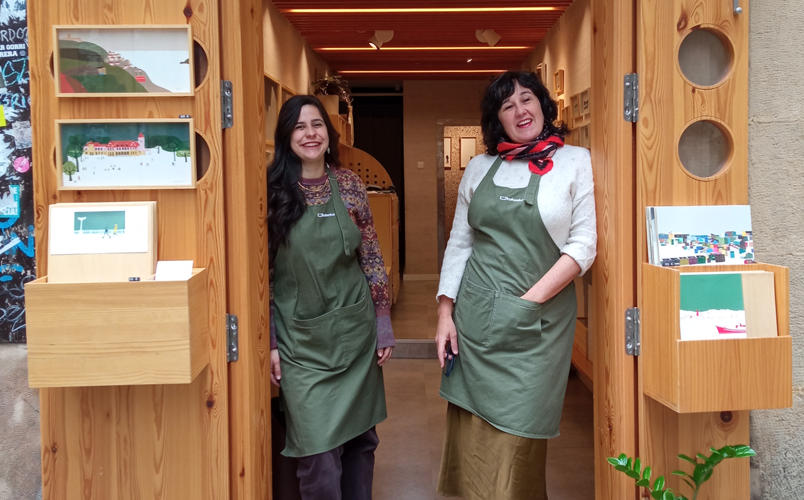
Nerea
A small stall, a big start
It all began in 2011, when Nerea first went to the monthly market organised by the Gipuzkoa artists’ association on Donostia’s Boulevard. “We started with a little stall, but a lot of enthusiasm,” she recalls. That initial spark gradually grew into Koloreka: a shop, a workshop and a space to share her unique way of seeing the world.
The philosophy behind Koloreka
For Nerea, Koloreka was born of a deep need: to convey calm. Each image she creates aims to bring peace and serenity. “I like creating images that give you a sense of calm. That make you pause, breathe and look.” Her art doesn’t shout; it whispers. And that's part of its magic.
Donostia as a source of inspiration
Donostia is not just the place where she lives or where her shop is; it is a constant muse. The city is present in her work, either directly or indirectly. “Riding a bike, watching the city, looking at the rooftops, the doorways, the sea ... All that inspires me. And it does it naturally — I don’t even have to try.”
When asked what she likes most about Donostia, she doesn’t hesitate: “The sea. I don’t realise how much I love it until someone makes me see it. The sea is in the air, as if it were part of you.” The trees, the architecture, everyday life — especially on typical winter days — also inspire her. “When the city is quiet, I enjoy it so much more.”
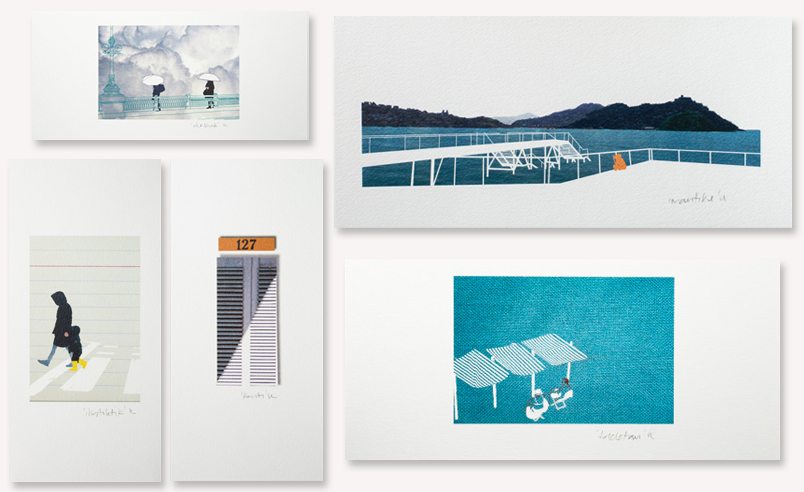
The creative process: observing, selecting, getting your hands dirty
Although she admits she would like to spend more time painting and less in front of the computer, Nerea is involved in every step of the creative process. She often starts with her own images and works by selecting which pieces to keep and which to remove until she finds the right composition.
And what does she do when no inspiration comes? “If you’re feeling blocked, it’s a sign of fear. What matters most is to keep going. Doing it, making mistakes, trying again. Getting your hands dirty. There aren't any shortcuts – creativity awakens through practice."
Art for everyone
Koloreka welcomes both locals and tourists alike. Visitors from elsewhere are often looking for a keepsake – something to take home or give to someone. Locals, on the other hand, tend to be more interested in larger works – pieces designed to decorate their homes. “Our aim is also to offer something special to local people – for our pieces to become part of their homes.”
Looking ahead: experimenting, exploring, listening
When it comes to what lies ahead, Nerea is clear: she doesn’t have a fixed plan, but she does have an open attitude. “I don’t know exactly what I want to do in the future, but I do know what I don’t want. It’s about staying attentive, listening to what motivates you and what you can do with what you have.”
In a world that often moves too fast, Nerea’s art and her Koloreka project invite us to pause, take a close look, and breathe. To find in the everyday — a façade, a wave, a balcony — a source of beauty and calm.
Silvia and the Spyglass: art and neuroscience
From calm we move to emotional intensity. Silvia's work isn't just seen, it is felt. And we're not being figurative here: two neuroscientific studies carried out with Tecnalia have demonstrated that her work transforms our emotions.
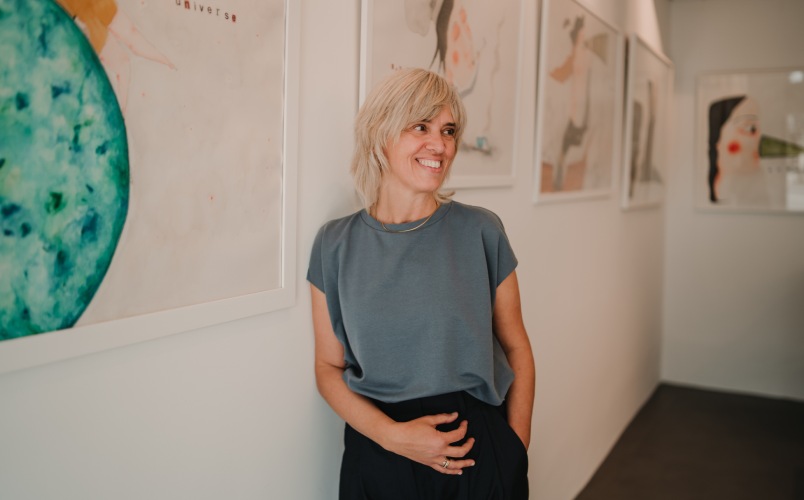
Silvia
First study: emotional immersion in virtual reality
Two years ago, seven of Silvia’s most iconic works were transformed into an immersive virtual reality experience. The paintings came to life in a four-minute audiovisual narrative that has toured exhibitions in France, Guatemala and the United Arab Emirates.
Viewers equipped with brain, pulse and sweat sensors were monitored as they experienced this artistic journey. The aim? To gauge how art affects emotional states.
And the result was clear: Silvia’s art alters our emotional state. Those who took part in the experiment came out emotionally changed. Each person interprets the work through their own story, their “emotional backpack,” triggering unique responses.
Gender differences and emotional expression
One interesting finding was the gender difference: while women openly connected with the emotional message of the work, many men admitted to “trying to hold back” when the experiment came to an end. A reflection of cultural conditioning around male vulnerability.
Second study: emotions mapped in the physical artwork
The second study was even more ambitious. 35 of Silvia’s paintings were analysed, with emotional responses measured using Robert Plutchik’s model of eight basic emotions.
The result: 80% of the emotional impact of her work is concentrated in positive emotions such as joy, surprise, trust and curiosity. Although some pieces also evoke sadness, fear or unease, the emotional coherence of the work is profound.
Art as an emotional catalyst
These studies have made it possible to scientifically measure what we feel when viewing art – something quite rare. Silvia offers not only a visual journey but an emotional map where each person discovers, through their own filters, a different version of themselves. Art that transforms.
Lance & Malone: local art with a street soul
And if Koloreka represents calm, and Silvia deep emotion, Lance & Malone is pure urban buzz. From their gallery-workshop in the Old Town, they have created a unique space combining collage, illustration, photography, pop culture and graphic humour.
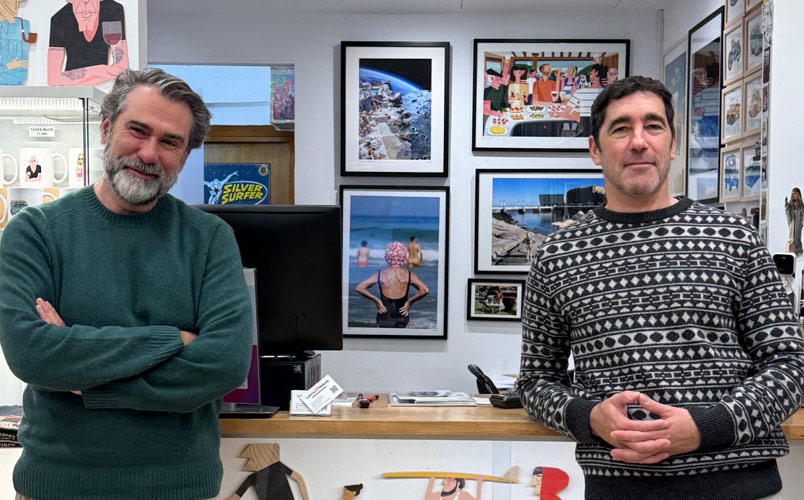
Lance
An idea that came from nowhere
Like many real-life projects, Lance & Malone was born without a plan. A friend told them about a vacant space, and without overthinking it they took the plunge: “We jumped in head first.” They started with a few of their own pieces, and little by little the walls began to fill up.
A collective with unique styles
From the start, Lance & Malone supported local artists such as Mikel Casal, Rosco and Roscow, along with their own creations. Today, every corner of the studio is filled with pieces in different styles, together in perfect harmony.
- Mikel Casal, an illustrator with a strong 1950s aesthetic, is known for his portraits of characters evoking classic editorial publications.
- Lance, a surf photographer, offers up his visual archive: images of the sea, of Donostia, and black-and-white street photography with a more intimate, personal touch. He also works with urban compositions, visual games, city scenes combined with surreal touches.
- Malone, his partner, creates 3D collages: layered images with clear influences from surf, skate and pop culture, such as Breaking Bad, James Bond, Back to the Future etc.
- Roscow, a Donostia painter with an unmistakable style, creates compositions without a single straight line. His works vibrate with the energy of the brushstroke and a saturation of detail.
- Rosco, an advertiser and digital collage artist, has gained prominence with a fun-packed, highly visual series on Basque produce: chistorra, zurito, marianito, cheesecake … pieces that combine humour, design and local culture.
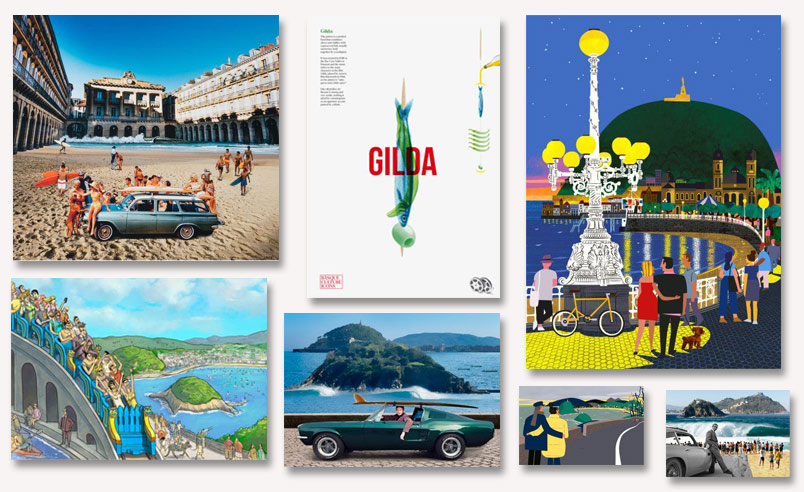
A natural connection with Donostia
Donostia is not only the location of the studio, but also a character in many of their works. Although the city often appears for its commercial value — many tourists want to take home a different kind of keepsake — for Lance & Malone there is something more. “We’re not a souvenir shop. We sell small pieces of art connected to the city."
Donostia, with its sea, mountain and architecture, fits perfectly into their visual language: for photography, illustration and collage alike, the city is an inspiring canvas.
Take a piece of this city away with you
Now you know about the creative buzz of Koloreka, the emotional intensity of Silvia & the Spyglass and the urban energy of Lance & Malone, we invite you to dive into this Donostia experience.
Don’t wait any longer to explore these three worlds and discover how, in Donostia, art slips into every corner and fills the air with a passionate embrace.
Take a piece of this city away with you and, above all, let each work talk to you directly.


